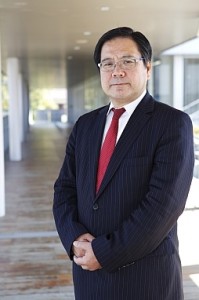Greetings at the beginning of the new academic year 2015
- Other
Director
Kaoru TAKARA
Spring has come with very beautiful cherry blossoms. The new academic year 2015 has just started. I believe all the readers including DPRI members and students welcomed this April with a refreshed mind. I would like to wish you all success in your research, education and other activities towards this year’s goals., and wish you all good health as well. As the new Director of DPRI, I will also do my best to fulfill my responsibilities. I hope to count on your strong and kind support.
I have appointed the following Vice Directors: Prof. Eiichi Nakakita (Future Planning), Prof. Kin’ya Nishigami (Research and Education), and Prof. Takashi Maruyama (Public Relations and Information Management); and Prof. Sumio Sawada as the Chairperson of the Self-Evaluation Committee. We will manage the various tasks and issues, both internal and external of DPRI. We cordially ask for your valuable suggestions, cooperation and support to DPRI.
A Global Center of Excellence
Last month, in March 2015, the Third United Nations (UN) World Conference on Disaster Risk Reduction (WCDRR) was held in Sendai, Japan. The Second conference, which was held in Kobe ten years ago in January 2005 – 10 years after the Kobe Earthquake disaster – adopted the Hyogo Framework for Action (HFA) as action goals during the decade of 2005-2015. The Sendai Conference this time adopted the Sendai Framework for Disaster Risk Reduction (SFDRR) 2015-2030. Its seven global targets in brief are to: (a) Substantially reduce global disaster mortality by 2030, (b) Substantially reduce the number of affected people globally by 2030, (c) Reduce direct disaster economic loss in relation to global gross domestic product (GDP) by 2030, (d) Substantially reduce disaster damage to critical infrastructure and disruption of basic services, among them health and educational facilities, including through developing their resilience by 2030, (e) Substantially increase the number of countries with national and local disaster risk reduction strategies by 2020, (f) Substantially enhance international cooperation to developing countries through adequate and sustainable support to complement their national actions for implementation of this framework by 2030, and (g) Substantially increase the availability of and access to multi-hazard early warning systems and disaster risk information and assessments to the people by 2030.
DPRI hosted, immediately after the Sendai Conference, the Second Global Summit of Research Institutes for Disaster Risk Reduction (GSRIDRR) at Uji Campus, Kyoto University on March 19-20, 2015, while the First Summit was held in November 2011 at the same time when we celebrated our 60th anniversary of the establishment of DPRI in 1951. The Second Summit this time gathered 86 institutions (56 international and 30 domestic) and 186 participants (71 from abroad and 115 from Japan) from 21 countries/areas. We were pleased to have Kyoto University’s Executive Vice-President, Professor Kayo Inaba deliver special remarks during the Summit banquet. The Second Summit was very fruitful for all the participating organizations from many parts of the world who developed a research road map for the next decade, and agreed with the establishment of the Global Alliance of Disaster Research Institutes (GADRI). It was also agreed that its secretariat will be managed by DPRI, Kyoto University and Prof. Hirokazu Tatano was appointed as the Secretary-General of GADRI. Undoubtedly, the international activities and efforts of DPRI are tangible and substantial, and moving towards becoming a real global center of excellence in research and education in disaster risk reduction. Considering global initiatives such as the Sendai Framework for Disaster Risk Reduction (SFDRR) 2015-2030, and the Sustainable Development Goals (SDGs) to be adopted at the United Nations General Conference in September 2015, I would like to further develop DPRI’s reputation in the world, making efforts to establish effective systems for this.
Relocation of Shirahama Oceanographic Observatory and Final Symposium of Public Policy on Disaster Reduction Research Section
The Research Center for Fluvial and Coastal Disasters relocated the Shirahama Oceanographic Observatory from the coast line, where it was established in 1966, to a higher location in Shirahama, Wakayama Prefecture. We will organize a ceremony for the reopening on April 24, 2015. I really hope further development of joint usage and research activities by this new facility with kind cooperation and strong supports by many users from inside and outside of Kyoto University.
The Public Policy on Disaster Reduction Research Section, which was attached to the Research Division of Disaster Management for Safe and Secure Society since May 2010 under the support of the Japan Institute of Country-ology and Engineering (JICE), will finish its five-year contract at the end of April 2015. The final symposia will be held in Uji Campus in the afternoon on April 21 and in Kyoto University Tokyo Office in Shinagawa in the morning of April 27. The symposia will review the outcomes of the five-year mission and commemorate active contribution by Prof. Jun’ichi Yoshitani, Asst. Prof. Mika Shimizu, former Prof. Nario Yasuda and former Assoc. Prof. Yoshio Kajitani. You are welcome to join these events.
Last but not least, I would like to express our sincere thanks to the former Director of DPRI, Professor Naoto Oshiman, and his executives Prof. Tomotaka Iwata, Prof. Hiroshi Kawase, Prof. Hirokazu Tatano and Prof. Tomoharu Hori for their enthusiastic efforts to not only international affairs such as the Global Summit but also many other difficult tasks of restructuring issues, cooperation with other research institutes, self-evaluations and external evaluation, etc.






